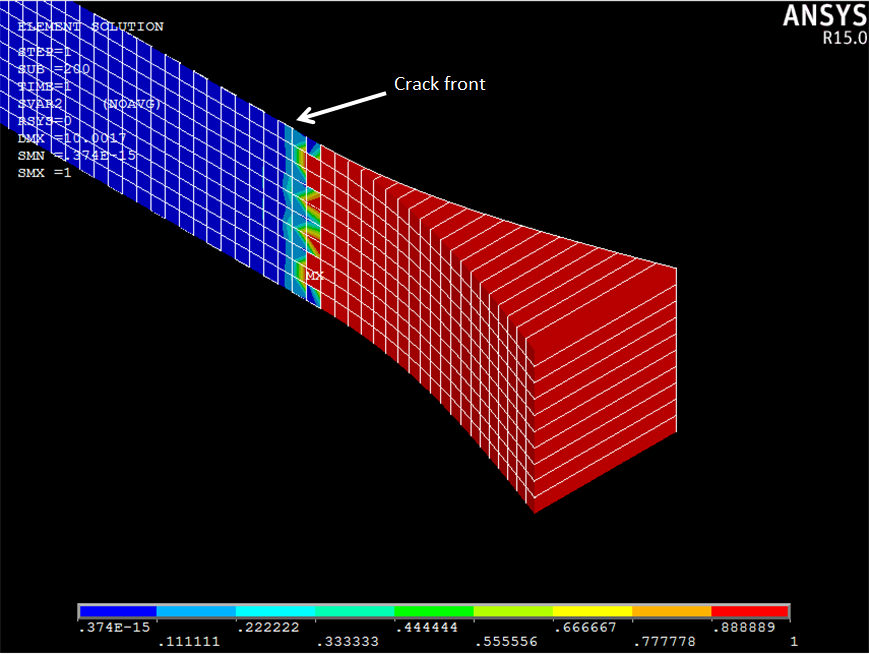View the state variable outputs from Helius PFA that are stored in the results file.
Refer to Appendix D of the Helius PFA User's Guide for definitions of all 9 cohesive material state variables.
- After the solution has completed, click Main Menu > General Postproc.
State variable SVAR1 represents the damage state at each integration point in cohesive elements that use Helius PFA cohesive materials. This value is an integer between 0 and 26. A value of 0 means damage has not initiated and a value of 26 means damage has fully evolved at the integration point and its stiffness has been reduced to zero. Intermediate values, say a value of 10, mean that damage has initiated and the stiffness of the element has been partially reduced.
- To view an element solution for SVAR1, type PLESOL, SVAR, 1 into the command prompt. Click Plot > Replot.
- Progress through the load history and note the progression of SVAR1 (Main Menu > General Postproc > Read Results > By Load Step or use the SET command).
- Notice that each failed integration point goes from unfailed (SVAR1 = 0) to fully failed (SVAR1 = 26) in the span of one increment. This is simply a result of the extreme delamination being forced onto the beam. More complex loadings will typically result in a progression of SVAR1 values.

State variable SVAR2 represents the failure index at each integration point. It is a continuous variable that can have a value between 0 and 1. A value of 0 indicates there are no stresses (or only normal compressive stresses) at the integration point. A value of 1 indicates that the failure initiation criterion has been satisfied and the process of damage evolution (stiffness reduction) has begun at the integration point. Intermediate values, for example 0.50, mean that 50% of the failure initiation criterion has been satisfied.
- Notice that each failed integration point goes from unfailed (SVAR1 = 0) to fully failed (SVAR1 = 26) in the span of one increment. This is simply a result of the extreme delamination being forced onto the beam. More complex loadings will typically result in a progression of SVAR1 values.
- Display just the cohesive elements (Select > Entities > Elements > By Attributes > Material num = 102) and plot SVAR2 (PLESOL, SVAR, 2) as shown below.
- Progress through the load history and probe the values of SVAR2 at the advancing crack front. Note: For the failed integration points, SVAR2 = 1. At the failure front (the region between unfailed and failed elements), the values are 0 < SVAR2 < 1.

Another useful state variable is SVAR6, which is referred to as the damage variable (D). SVAR6 is a continuous variable between 0 and 1 that indicates how much damage has occurred at the integration point. A value of 0 corresponds to an undamaged integration point that has its original (full) stiffness. A value of 1 corresponds to a fully degraded (zero stiffness) integration point.
In summary, SVAR2 can be thought of as a 'pre-failure' measure of how close the integration point is to failure initiation. SVAR6 can be thought of as a 'post-failure' measure of how close the integration point is to complete stiffness reduction after failure initiation.
Refer to the ANSYS APDL documentation for additional details on the PLESOL command.